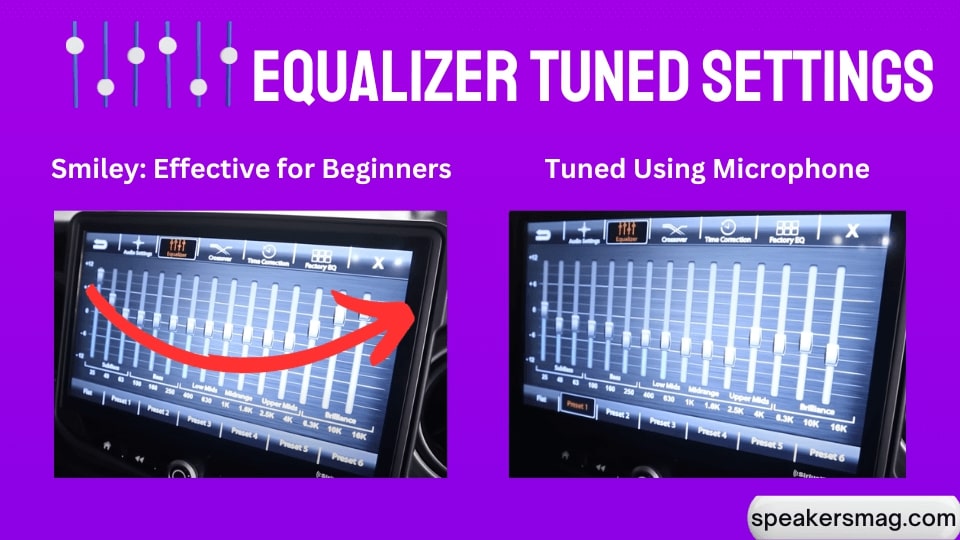You are on an outlook to enhance your car audio experience, Right? Well, a subwoofer proves to be a game-changer, but it’s not the only piece of the puzzle. An often-overlooked but crucial aspect of fine-tuning is finding the best equalizer settings for car with sub like yours!
You must have given it a shot and were concerned about the sound getting sharper or irritating. Do you need to increase the treble, mid, and the bass, too? Well, no, you need to make a balanced change; indeed, the bass will be high, but what about the rest?
The article gives deep analysis to provide a comprehensive understanding of choosing appropriate frequency settings for Equalizer, regardless of whether you’re a newcomer or a seasoned car audio enthusiast.
Also, we have got you covered if you’re using built-in tweeters or sub and whether your car features a factory-installed or an aftermarket head unit that hasn’t been equipped with DSP.
First, you need to know what an equalizer does and, later, how time correction is related when fixing the equalizer settings.

What is an Equalizer and what’s its Function?
An equalizer in a car is a device or software that allows you to adjust the volume/amplitude of different frequency bands in your vehicle’s sound system. This lets you customize the sound to your liking and improve the overall listening experience.
Most newer vehicles come with a built-in equalizer in the default head unit. However, some older vehicles or lower-end trim levels may not have this feature. If your car does not have an equalizer, you will need to purchase an aftermarket head unit that has this feature.
What happens when we adjust the equalizer settings?
Equalizer enhances the audio experience by fine-tuning sub-bass, bass, midrange, and treble frequencies. It allows you to balance and adjust fundamentals, overtones, and percussive elements to your preference. But mainly the amplitude of over tunes is adjusted.
Now, let’s move on to the next step that you’ve been eagerly anticipating: discovering the optimal equalizer settings for a car with a subwoofer.
Best Equalizer Settings for Car with Subwoofer
There are two main types of aftermarket head units: graphic equalizers and preamp-style DSP (digital signal processors). There is no right or wrong answer when adjusting the equalizer settings on these head units for cars with sub, these settings depend on your personal preferences.
To tune your equalizer, it is best to use a calibrated tuning measurement microphone. This will help you to ensure that you are getting an accurate picture of the frequency response of your system.
However, there are some general tips that can help you get a good starting point:
Don’t boost the mid-range frequencies
Your ears are already more sensitive to these frequencies, so boosting them will make the sound unbalanced.
Reduce the lows and highs slightly
This will help to avoid a “hill-shaped” equalizer setting, which can make the sound harsh and fatiguing.

Try a smiley face EQ curve
This boosts the lows and highs slightly, which can make the sound more vivid and compensate for the natural roll-off of bass and treble frequencies at lower volumes.
Use a flat EQ setting
If you want a balanced sound use a flat EQ setting at zero dB. This will give all frequencies equal weight.
Loudness Setting
The loudness setting on your head unit can also affect the sound quality. If you find yourself relying on it, consider upgrading your system for better sound quality. A well-set EQ can make the loudness settings unnecessary.
Important Note: Keep in mind that any change in the frequencies of the equalizer will affect all speakers in your car. This is because the equalizer is applied to the audio signal before it is sent to the speakers.
If you want to have more control over the equalization of your car audio system, you will need to install a DSP (digital signal processor).
A DSP allows you to control the equalization for each individual speaker. This is important because different speakers have different frequency responses.
Another important setting to consider is time correction. Time correction allows you to adjust the delay of the audio signal to each speaker so that all of the speakers are in phase. Let’s see it in detail.
Time Correction Tuning Procedure
If you have subwoofers in your car, you may want to consider using time correction to improve the sound quality. Time correction allows you to adjust the delay of the audio signal to each speaker so that all of the speakers are in phase. This can help to create a more cohesive and immersive soundstage.
How to Use Time correction?
To use time correction, you will need to measure the distance from your listening position to each subwoofer. Once you have these measurements, you can input them into your head unit or DSP. The head unit or DSP will then calculate the appropriate delay for each subwoofer.
Here is a step-by-step guide to time correction tuning for subwoofers:
- Measure the distance from your listening position (usually the driver’s seat) to each subwoofer.
- Input the distance measurements into your head unit or DSP.
- Play a test tone and adjust the delay for each subwoofer until the sound is centered and balanced.
- If you have one subwoofer, you can use the average distance measurement from both ears.
- If you have two subwoofers, you can use the same delay for both subwoofers if you are using a mono signal. However, if you are using stereo signals, you may need to use different delays for each subwoofer.
- You may need to experiment with the delay settings to find what sounds best to you.
No one is excluded. If your car lacks subs or an aftermarket head unit, then following settings are for you.
